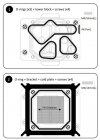OKAY the loop is bled, my work is done for the day, and it's time to share some pictures and data!
---
First, some unboxing and first impression photos:
The new cold plate fins are pretty.
O-rings are certainly more of a pain in the Extreme version but very doable. The video provided by Nouvolo is a good method and works well.
Assembled photos:
My build is in the FormD T1. I used the fill port on the "IN" side of the block as my primary fill point and connected it to the G 1/4" pass through at the back of the case.
I was able to do the bulk of my filling via this port but I've made it a habit to always have two fill ports and found that I was able to set the case upside down and get the small, frothier bubbles out of the loop via a ball fitting on the GPU. This fitting is also essentially the drain port and houses my water temperature sensor.
Some photos of the block installed as well as a look at the fill port connection (hard to get a good photo in there - sorry):
And finally some photos of the completed build:
---
Now for some testing data.
I haven't tested directly against the original Aquanaut since acquiring the Extreme but I do have data from an old build that was configured essentially identically to this one but with the original Aquanaut. I'll consider this good enough to draw some conclusions, though I do intend to do a more direct and managed comparison when I have more time.
Build with ORIGINAL Aquanaut:
- Heaven Benchmark looped for 30 minutes, all side panels closed, average readings taken from last 5 mins of the test:
- CPU: 79.3C
- GPU: 64C
- Water: 47.5C
- Fans: 1575 RPM
Build with Aquanaut EXTREME:
- Port Royal benchmark looped for 30 minutes, all side panels closed, average readings taken from last 5 mins of the test:
- CPU: 59.4C
- GPU: 61.3C
- Water: 48.8C
- Fans: 1325 RPM
For completeness, I've also run a 30 min Cinebench R23 Multi-core test and recorded data. I don't have any old data points to compare against this though:
- CPU: 65.6C
- GPU: 36.5C
- Water: 38.2C
- Fans: 1015 RPM
It's safe to say this is a huge improvement. I'm excited to see whether others see a similar improvement to validate my results. I am VERY happy with this iteration of the product though.
Fill loop is a great addition and the performance seems to speak for itself.
If anyone's got any questions, I'm happy to answer them!






